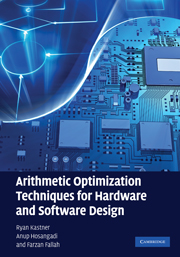7 - Linear systems
Published online by Cambridge University Press: 03 May 2010
Summary
Chapter overview
This chapter provides a thorough discussion of the issues surrounding the optimization of linear systems. Section 7.2 describes fundamental properties, and presents a list of common linear transforms. Then, Section 7.3 formalizes the problem. Sections 7.4 and 7.5 introduce two important cases of linear system optimization, namely single- and multiple-constant multiplication. While the algorithms to solve these problems are important, they do not fully take advantage of the solution space; thus, they may lead to inferior results. Section 7.6 describes the relationship of these two problems to the linear system optimization problem and provides an overview of techniques used to optimize linear systems. Section 7.7 presents a transformation from a linear system into a set of polynomial expressions. The algorithms presented later in the chapter use this transformation during optimization. Section 7.8 describes an algorithm for optimizing expressions for synthesis using two-operand adders. The results in Section 7.9 describe the synthesis of high-speed FIR filters using this two-operand optimization along with other common techniques for FIR filter synthesis. Then, Section 7.10 focuses on more complex architectures, in particular, those using three-operand adders, and shows how CSAs can speed up the calculation of linear systems. Section 7.11 discusses how to consider timing constraints by modifying the previously presented optimization techniques. Specifically, the section describes ideas for performing delay aware optimization.
- Type
- Chapter
- Information
- Publisher: Cambridge University PressPrint publication year: 2010

